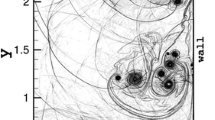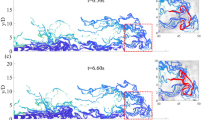Abstract
A three-dimensional CFD model, based on large eddy simulation, is utilized to numerically simulate a perpendicular interaction between a traveling tornado-like vortex and a wide rigid wall. The tornado-like flow is modeled by the Rankine-Combined Vortex Model. The case, where the wall width is much larger than the tornado vortex core diameter is examined. The main goal of the paper is to improve the understanding of the dynamics of the tornado–wall interaction. The conclusions drawn in this study are supported by various visualizations. During the tornado impact, the structure of the tornado-like vortex is substantially mitigated by the wide wall. The low-level portion of the vortex is disturbed both in front of the wall and behind the wall. When the vortex is approaching the wall, the vortex-induced velocities cause a boundary layer separation from the leading face of the wall. The ejected, from the wall, vorticity patches wrap around the tornado-like vortex causing its weakening. Behind the wall the tornado vortex is subjected to the turbulent flow that further disrupts the tornado vortex structure. The tornado-like vortex mitigation results in a low wind speed region behind the tornado-break wall, where the wind velocities are reduced by more than 50 %.
Graphical Abstract
















Similar content being viewed by others
References
Affes H, Conlisk AT (1993) Model for rotor tip vortex–airframe interaction. I—Theory. AIAA J 31(12):2263–2273
Coton F, Marshall J, Galbraith R, Green R (2004) Helicopter tail rotor orthogonal blade vortex interaction. Prog Aerosp Sci 40(7):453–486
Filippone A, Afgan I (2008) Orthogonal blade–vortex interaction on a helicopter tail rotor. AIAA J 46(6):1476–1489
Gorecki P, Selvam RP (2013) Three-dimensional simulation of tornado over complex terrain. In: Proceedings of 12th Americas conference on wind engineering, Seattle WA, USA
Haan FL, Sarkar PP, Balaramudu VK (2008) Non-stationaty tornado-induced wind loads compared with traditional boundary layer wind loads on low-rise buildings. In: Proceedings of BBAA VI international colloquium on: bluff bodies aerodynamics & applications, Milano, Italy
Haan FL, Balaramudu VK, Sarkar PP (2010) Tornado-induced wind loads on a low-rise building. J Struct Eng-ASCE 136(1):106–116
Kosiba KA, Robinson P, Chan PW, Wurman J (2014) Wind field of a nonmesocyclone anticyclonic tornado crossing the Hong Kong International Airport. Adv Meteorol 2014:1–7
Krishnamoorthy S, Marshall JS (1998) Three-dimensional blade–vortex interaction in the strong vortex regime. Phys Fluids 10(11):2828–2845
Krishnamoorthy S, Gossler AA, Marshall JS (1999) Normal vortex interaction with a circular cylinder. AIAA J 37(1):50–57
Marshall JS (2002) Models of secondary vorticity evolution during normal vortex–cylinder interaction. AIAA J 40(1):170–172
Marshall JS, Beninati ML (2005) External turbulence interaction with a columnar vortex. J Fluid Mech 540:221–245
McDonald JR, Selvam RP (1985) Tornado forces on buildings using the boundary element method. In: Proceedings of Fifth U.S. National Conference on Wind Engineering 5B:41–48
Mishra AR, James DL, Letchford CW (2008) Physical simulation of a single-celled tornado-like vortex, part B: wind loading on a cubical model. J Wind Eng Ind Aerod 96:1258–1273
Murakami S, Mochida A (1995) On turbulent vortex-shedding flow past 2D square cylinder predicted by CFD. J Wind Eng Ind Aerod 54(55):191–211
Orlandi P, Verzicco R (1993) Vortex rings impinging on walls: axisymmetric and three-dimensional simulations. J Fluid Mech 256:615–646
Raine J, Stevenson D (1977) Wind protection by model fences in a simulated atmospheric boundary layer. J Wind Eng Ind Aerod 2(2):159–180
Rockwell D (1998) Vortex–body interactions. Annu Rev Fluid Mech 30(1):199–229
Selvam RP (1985) Application of the boundary element method for tornado forces on building. Dissertation, Texas Tech University, Lubbock
Selvam RP, Gorecki P (2012) CFD for infrastructure, thermal management and energy. In: Proceedings of international conference on application of fluid dynamics. Gaborone, Botswana
Selvam RP, Millett PC (2003) Computer modeling of tornado forces on buildings. Wind Struct 6:209–220
Selvam RP, Millett PC (2005) Large eddy simulation of the tornado–structure interaction to determine structural loadings. Wind Struct 8:49–60
Sengupta A, Haan FL, Sarkar PP, Balaramudu V (2008) Investigation of tornado transient loads on buildings in microburst and tornado winds. J Wind Eng Ind Aerod 96:2173–2187
Wen Y (1975) Dynamic tornadic wind loads on tall buildings. J Struct Div-ASCE 101(1):169–185
Wurman J, Robinson P, Alexander C, Richardson Y (2007) Low-level winds in tornadoes and potential catastrophic tornado impacts in urban areas. B Am Meteorol Soc 88(1):31–46
Yang Z, Sarkar PP, Hu H (2010) Visualization of flow structures around gable-roofed building model in tornado-like winds. J Visual-Japan 13:285–288
Author information
Authors and Affiliations
Corresponding author
Electronic supplementary material
Below is the link to the electronic supplementary material.
Supplementary material 1 (MPG 3,545 kb)
Supplementary material 2 (MPG 3,681 kb)
Rights and permissions
About this article
Cite this article
Gorecki, P.M., Selvam, R.P. Visualization of tornado-like vortex interacting with wide tornado-break wall. J Vis 18, 393–406 (2015). https://doi.org/10.1007/s12650-014-0245-y
Received:
Revised:
Accepted:
Published:
Issue Date:
DOI: https://doi.org/10.1007/s12650-014-0245-y




